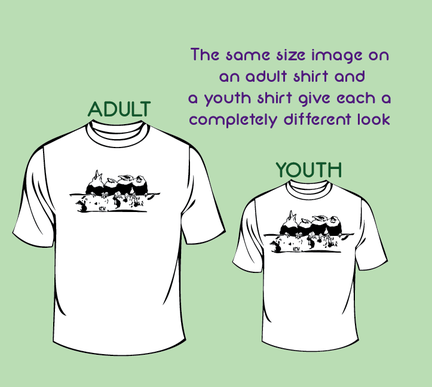Vector Art
What kind of artwork or files do I need to send for "production ready" artwork?
All artwork for screen printing and ad specialties must be converted into vector artwork. Many files such as JPEG,PNG, TIFF and DOC. are raster images that will need to be traced or "vectorized" before they are ready for production. The vector image must then be color separated and each color must be converted to a spot color. Color separation allows us to put each color on a separate screen and the spot color allows for higher consistency in the screen burning process.
For more information on what it takes to submit production ready artwork visit our Artwork Requirements page.
What is vector artwork?
Vector artwork is made up of paths instead of pixels. Because of this, a vector image can be made any size without losing quality. (See photo above!) It also separates images into different parts rather than one large, flat image. Have you ever tried to make a digital picture larger and it just gets blurry? Vectorization solves this problem! Common formats of Vector images are .AI, EPS, and SVG.
Please keep in mind that the extension of the file itself does not always determine whether or not an image is a vector. Sometimes raster images may be inserted into AI files and will still need to be converted.
If you are unsure if your artwork is vectorized please email it to us at tshirtsales@alaska.net for a free consultation and conversion estimate.
Do I have to send production ready artwork?
Absolutely not! We are happy to get any type of artwork (photographs, doodles, JPEGs, hand drawn designs- we mean anything!) production ready for you!
How many colors can I have printed?
Generally speaking we will screen print up to 6 colors (5 if an underlay is needed and there is no white in the design).
Direct to Garment printing (DTG) we can print an unlimited number of colors!
Underlay
Why do I need an additional white screen when there isn't white in my design?
Many times when printing on darker and some medium colored garments an underlay is needed in order to maintain the brightness and saturation of the inks. An underlay acts as a primer base for inks. It is an additional screen that lays down a layer of white ink (or sometimes clear) underneath the entire image. This technique allows almost any ink color to stay true to its original (and intended color) on nearly any color garment. Sometimes, if the design already has white in it, the underlay and white portions of the design can be incorporated on the same screen! Lighter colored garments (with a few design exceptions) do not need underlays.(Example Photos Coming Soon!) |
Standard Sizing

Why do I need another set up for smaller shirts?
Different garments and products require different sized images. Generally speaking a different set of screens is needed for each group of sizing.The image on each screen cannot be changed once it is burned onto the screen. Printing the same sized image on different sized shirts gives the garment a completely different look that may not be desired. Other times the image simply won't fit on the smaller garments. You may specify specific or general (ie. standard, bigger, smaller) dimensions when you place your order and we will make sure you get the sizing and look that you want!
Please note that the sizing of your artwork is dependent on what sizes and style of shirts you order. Many times seams and color-blocks can limit the size of a print. We are more than happy to print off an actual size image of your print and lay it out on the garment for you to see!
Your customer service representative or our graphic artists will always confirm your approval of both the artwork and dimensions before production begins.


